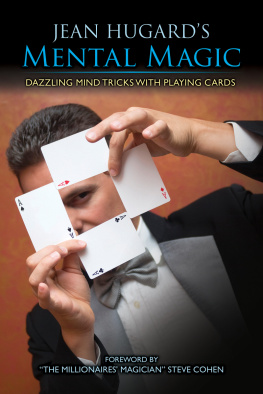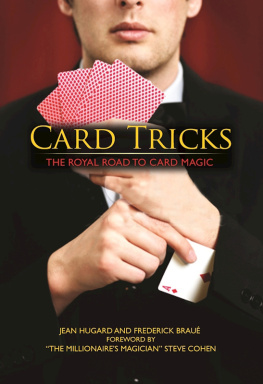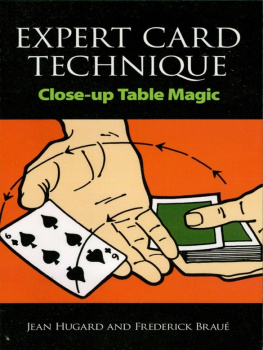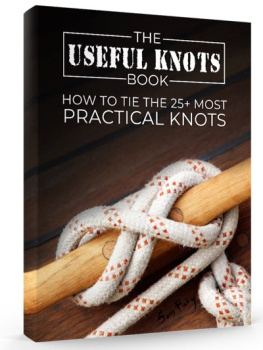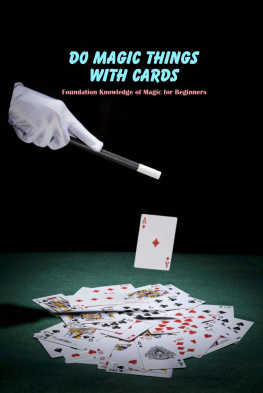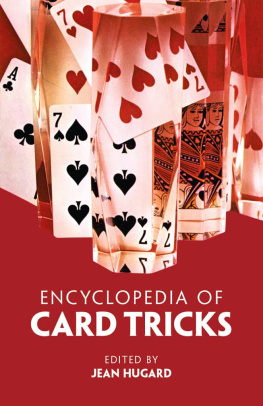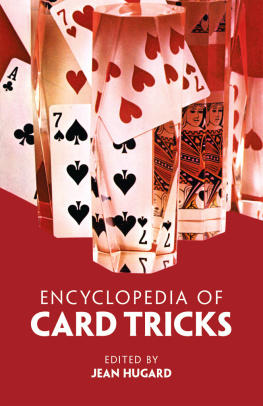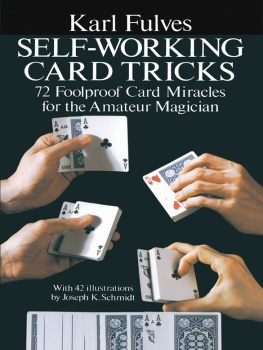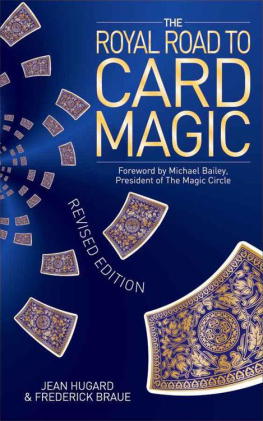
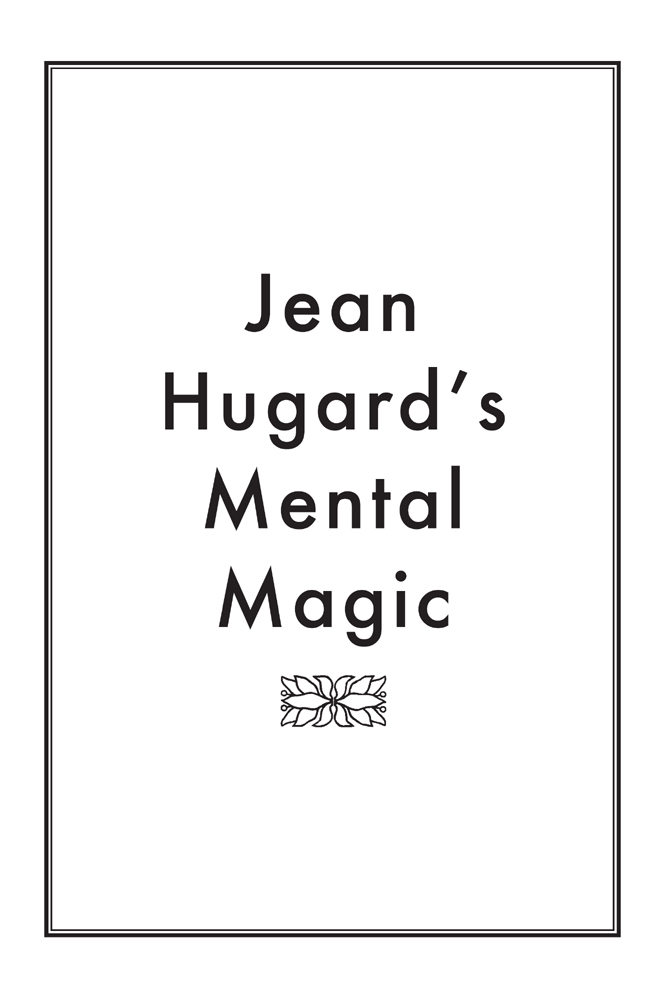
Originally published in 1935 by Calostro Publications
First Racehorse Publishing edition 2018
Foreword copyright 2018 by Racehorse Publishing
All rights to any and all materials in copyright owned by the publisher are strictly reserved by the publisher.
Racehorse Publishing books may be purchased in bulk at special discounts for sales promotion, corporate gifts, fund-raising, or educational purposes. Special editions can also be created to specifications. For details, contact the Special Sales Department, Skyhorse Publishing, 307 West 36th Street, 11th Floor, New York, NY 10018 or .
Racehorse Publishing is a pending trademark of Skyhorse Publishing, Inc., a Delaware corporation.
Visit our website at www.skyhorsepublishing.com.
10 9 8 7 6 5 4 3 2 1
Cover photo credit: Shutterstock
Print ISBN: 978-1-6315-8244-8
E-Book ISBN: 978-1-6315-8246-2
Printed in the United States of America
FOREWORD
F or the past sixteen years, I have started my Chamber Magic show with a mental card trick. Heres how it looks: I divide the deck into several piles, hand those piles to nearby audience members, and instruct them to shuffle. The packets are reassembled into one thoroughly mixed deck. A participant in the front row glances at the randomly shuffled cards and remembers one without saying the card out loud. Against all odds, I reveal the card she has mentally chosen. Her reaction: Applause? Nosilence. She is stunned in her tracks.
This is no pick-a-card-any-card trick. The spectator chooses a card mentally, not physically, and I accurately reveal her selection. It does not seem possible, yet Ive performed this trick for thousands of people and gotten it right every time.
Audiences are convinced that there is no sleight of hand in tricks like these, because the magician is not seen to do anything. But in most cases, mental magic does not require knuckle-busting skill. Rather, this genre of card magic requires a good deal of advanced preparation that unfolds elegantly during the performance to create the deceptive illusion of mindreading. Because the audience cannot perceive any tricky movements, the demonstration appears genuine.
If you have spent time learning the standard sleights of card conjuring, such as palms, forces, and the double lift, you know that your skill is on display while you perform. You must practice until the secret moves are imperceptible and your overt actions appear natural. Nevertheless, you are working during each trick, executing physical maneuvers in front of your audience.
Mental card magic takes a different approach. Much of the work occurs before the show, and the preparation may require hours of mental strain or involved arts and crafts projects. You may need to doctor each card with a sharp pin or razor blade so that specific cards can be discerned by touch. You may need to learn an elaborate verbal code, and teach it to your friend, so that you can cue certain cards to each other while holding an apparently natural conversation. You may need to prearrange and memorize every card in the deck, and be able to recite them in order, both backwards and forwards. The most difficult element of mental card magic is the intense preparation; during the performance itself, little digital skill is required. More important to this genre is the ability to dramatically sell the audience on your apparent mental powers. Showmanship is paramount, and you must spend as much time writing and rehearsing your presentation as an actor does learning a script.
Why does the spectator react in stunned silence to my opening trick, described above? There is something immensely personal about our thoughts. Seeing a magician effortlessly name a thought-of card has greater implications, and causes people to wonder if theyve witnessed a trick or something potentially real. Because we all want to know the unknowable, demonstrations of apparent mind-reading strike a chord common to all people. What are the implications of this power, they wonder. How would I use this skill in my own life? Can I read the mind of my girlfriend, my spouse? A common retort I hear from husbands is, Can you teach me that? Ive been trying to read her mind for thirty years!
Theodore Annemann wrote that mental magic is the most adult form of magic. It contains a built-in appeal that extends to even the smartest and most successful. Jean Hugard published Mental Magic with Cards in 1935, but the material contained in these pages will baffle modern audiences with the same degree of mystery and intrigue. The tricks in this book are timeless because the desire to read anothers thoughts has existed since time immemorial.
Do not be disappointed with the methodology presented by Hugard. Some concepts, like the Key Card, may seem simplistic, but these effects contain built-in impact. The cards serve simply as a tool the real drama lies in your apparent ability to divine the spectators thoughts. This is where you must flex your acting muscles. Learn how to stretch out a revelation: instead of blurting out the name of a thought-of card, reveal it in stages. For instance, Your card is a high card... I believe it is red. Most ladies choose diamonds, but I think you tried to throw me off by choosing a heart. It could be the jack, but no! Sit up straight. Look into my eyes... Hmmm. You chose the ten. The ten of hearts? Yes! The audience is interested in the process. Of course you could simply blurt out The ten of hearts! and correctly name the selection. But the intrigue arises when the audience sees you working for it. Why did he tell her to sit up straight? Do women typically choose diamonds? By throwing down imaginary breadcrumbs, the audience feeds itself a greater mystery. After all, they presume, the magician wouldnt have given those instructions if they didnt serve a genuine purpose.
downward at the same time. Even better, avert your gaze the moment you have glimpsed the force card so that it appears you never faced the cards at all. Small details like this add another layer of deception that enhances the illusion. As S.W. Erdnase wrote in Expert at the Card Table, the most critical observer should not suspect, let alone detect, the action.
In , Hugard mentions a ruse of glimpsing key cards while apparently searching for the Joker. I learned this strategy by watching Harry Lorayne openly set up a deck for not only the next trick, but for the trick after that. Talk about planning ahead! Sometimes he would purposely pass by a Joker as if he hadnt seen it, and then return to retrieve that Joker when his set up was complete. Once again, this requires a good deal of natural acting so that the audience believes you are simply spreading the deck. Little do they suspect that you have a silent, ulterior motive.
Check out The Countdown in . Secretly set the top and bottom key cards while hunting for the Joker, and you will be able to reveal both a thought-of card and a number. The audience will naturally expect you to reveal the card, but will be surprised when you can correctly guess the mentally chosen number. I like that a kicker ending is built into the construction of the trick.
deck face-up, and overhand shuffle the top four cards again, singly, into your left hand. Throw the remainder of the face-up deck on top. Execute this false overhand shuffle while talking to your audience, without looking at your hands. It feels natural, and appears to the casual observer that you are absent-mindedly mixing the cards. In fact, the order of the entire deck remains unchanged.
Next page
